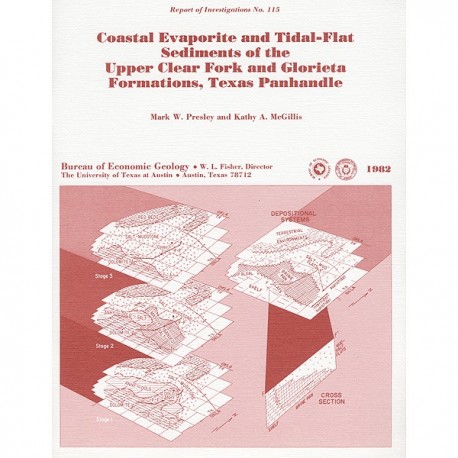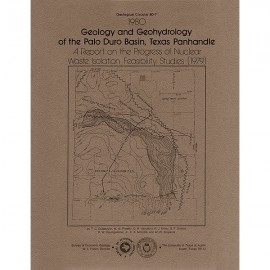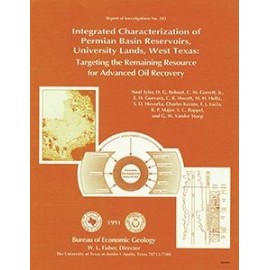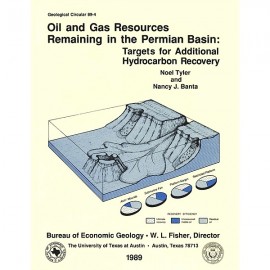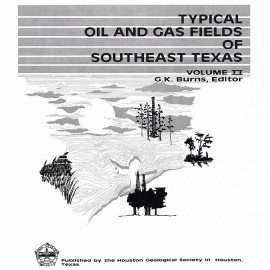Reports of Investigations
-
Books & Reports
- Reports of Investigations
- Guidebooks
- Udden Series
- Geological Circulars
- Down To Earth
- Atlases of Major Oil and Gas Reservoirs
- Texas Memorial Museum Publications
- Environmental Geologic Atlas of the Texas Coastal Zone
- Mineral Resource Circulars
- Other Reports
- Seminars and Workshops
- Handbooks
- Submerged Lands of Texas
- Symposia
- Annual Reports
- Open File Reports
-
Maps & Cross Sections
- Thematic Maps
- Miscellaneous Maps, Charts & Sections
- Geologic Atlas of Texas
- STATEMAP Project Maps
- Geologic Quadrangle Maps
- Cross Sections
- Highway Geology Map
- Energy and Mineral Resource Maps
- Shoreline Change and Other Posters
- Wilcox Group, East Texas, Geological / Hydrological Folios
- Bouguer Gravity Atlas of Texas
- River Basin Regional Studies
- Featured Maps
- Posters
- Teachers & the Public
-
Geological Society Publications
- Gulf Coast Association of Geological Societies
- Alabama Geological Society
- Austin Geological Society
- Corpus Christi Geological Society
- Houston Geological Society
- Lafayette Geological Society
- Mississippi Geological Society
- New Orleans Geological Society
- South Texas Geological Society
- GCS SEPM Publications
- Historic BEG & UT Series
Coastal Evaporite and Tidal-Flat Sediments of the Upper Clear Fork and Glorieta Formations, Texas Panhandle
RI0115
Coastal Evaporite and Tidal-Flat Sediments of the Upper Clear Fork and Glorieta Formations, Texas Panhandle, by M. W. Presley and K. A. McGillis. 50 p., 38 figs., 5 tables, 1982. ISSN: 0082335X: Print Version.
A free, digital version of this publication can be found on: Texas ScholarWorks
RI0115. Coastal Evaporite and Tidal-Flat Sediments of the Upper Clear Fork and Glorieta Formations, Texas Panhandle, by M. W. Presley and K. A. McGillis. 50 p., 38 figs., 5 tables, 1982. ISSN: 0082335X: Print.
To purchase this publication as a downloadable PDF, please order RI0115D.
ABSTRACT
Red beds, evaporites, and carbonates of the upper Clear Fork and Glorieta Formations (Permian) of the Texas Panhandle form an association of facies deposited in nearshore and supratidal environments along an arid coastline. Carbonates were deposited in inner-shelf depositional environments and exhibit upward-shoaling, sabkha-like successions of dolomitic mudstones containing nodular anhydrite. Landward of the shoaling carbonates was a vast salt plain, or sabkha, in which evaporites were deposited in supratidal brine pans and salt flats. Brine pan environments on the seaward parts of the salt plain were intermittently flooded by periodic tides or ground-water seepage. Deposits of gypsum and relatively pure halite formed in the shallow ponded waters. Salt-flat environments landward of brine pans were exposed for long periods of time. Evaporites in salt-flat environments were deposited in surficial salt crusts and interstitially in previously deposited carbonate, evaporite, or clastic host sediments. A common salt-flat facies is red siliciclastic mud in which displacive growth of halite crystals created chaotic mixtures of mud and salt.
The development of broad mud-rich tidal flats that extended across most of the study area periodically terminated evaporite sedimentation. The upper Clear Fork and Glorieta Formations are considered a single lithogenetic unit. Together these units define a broadly regressive cycle of deposition characterized by an increase in supply of clastic sediments through time. During the time of upper Clear Fork deposition, evaporite and carbonate depositional systems were predominant in the Texas Panhandle. In Glorieta time, clastic environments migrated basinward, and mudflat and salt-flat facies were deposited across much of the Texas Panhandle. In addition to the broad cycle of regression that characterizes the upper Clear Fork-Glorieta lithogenetic unit, there were multiple cycles of inner-shelf, brine pan, and salt-flat facies, which are a record of shorter term fluctuations in the pattern of sedimentation. These cyclic facies patterns were controlled by a delicate dynamic balance among competing processes of basin subsidence, eustatic sea-level variation, clastic sediment supply, and aggradation/progradation of intertidal and supratidal sediments.
Keywords: Clear Fork, Glorieta, Panhandle, Texas, red beds, evaporites, facies, salt-flat facies, sediments
CONTENTS
ABSTRACT
INTRODUCTION
Regional setting
Stratigraphy
Previous studies
Data
INNER-SHELF DEPOSITIONAL SYSTEMS
BRINE PAN DEPOSITIONAL SYSTEMS
Laminated dolomite
Nodular mosaic anhydrite
Laminated anhydrite
"Grass mat" anhydrite
Massive salt deposits
Restriction and salinities in brine pan environments
A modern brine pan analog at Karabogaz-Gol
SALT-FLAT DEPOSITIONAL SYSTEMS
MUD-FLAT DEPOSITIONAL SYSTEMS
General relations
Seaward transition from mud flats to sand flats
Landward transition from mud flats to continental environments
GEOLOGIC HISTORY
General history
Evolution of evaporite-carbonate cyclic units
Evolution of mud-flat facies units
Controls of facies variations
CONCLUSIONS
ACKNOWLEDGMENTS
REFERENCES
Figures
1. Regional structural setting of Palo Duro and Dalhart Basins
2. Diagrammatic north-south cross section of upper Clear Fork and Glorieta Formations and underlying and overlying units in Texas Panhandle
3. Evaporite and carbonate depositional facies and environments inferred for upper Clear Fork and Glorieta rocks
4. Clastic depositional facies and environments inferred for red-bed units of Glorieta Formation
5. Paleogeography during deposition of upper Clear Fork and Glorieta Formations
6. North-south cross section A-A', Upper Permian salt-bearing formations, Palo Duro and Dalhart Basins
7. Isopach map of upper Clear Fork-Glorieta lithogenetic unit, Palo Duro and Dalhart Basins
8. North-south cross section C-C', upper Clear Fork and Glorieta Formations, Dalhart and Palo Duro Basins
9. East-west cross section D-D', upper Clear Fork and Glorieta Formations, Palo Duro Basin
10. East-west cross section E-E', Clear Fork and Glorieta Formations, Dalhart Basin
11. Thickness of upper Clear Fork Formation in Palo Duro Basin
12. Thickness of Glorieta Formation in Palo Duro Basin
13. Facies interpretations of well logs, upper Clear Fork Formation
14. Facies interpretations of well logs, Glorieta Formation
15. Dolomite and anhydrite facies from upper Clear Fork Formation
16. Carbonate and evaporite environments on southern coast of Bonaire
17. Anhydrite facies from upper Clear Fork Formation
18. Regional map of northern Gulf of California
19. Massive salt facies from upper Clear Fork Formation
20. Modern brine pan and adjacent salt-flat environments at Karabogaz-Gol
21. Chaotic mudstone-salt, upper Clear Fork Formation
22. Mudstone facies in Glorieta Formation
23. Coastal sabkha environments of Laguna Ojo de Liebre
24. Laminated mudstone-siltstone facies of the Glorieta
25. Net sandstone in Glorieta Sandstone and equivalent rocks in north Texas
26. Core descriptions and mud-flat and eolian sandstone facies of Cedar Hills (Glorieta) Sandstone
27. Facies model for Glorieta Sandstone in the northwestern Texas Panhandle where unit intertongues with mudstone and salt
28. Net salt in upper Clear Fork Formation, Palo Duro and Dalhart Basins
29. Net salt in Glorieta Formation, Palo Duro Basin
30. Thickness of salt-bearing rocks in upper Clear Fork Formation, Palo Duro and Dalhart Basins
31. North-south facies cross section F-F', cycle 2A, upper Clear Fork Formation
32. Facies maps, cycle 2A, upper Clear Fork Formation
33. Distribution of facies in upper Clear Fork cyclic units
34. Summary maps of northern limits of anhydrite-dolomite beds and southern limits of salt beds n upper Clear Fork cyclic units
35. Facies distribution maps for Glorieta evaporite-carbonate units
36. Facies distribution maps for Glorieta elastic units
37. Diagrammatic representation of relation between Glorieta mud-flat depositional systems and evaporite-carbonate depositional systems
38. Percent mudstone in upper Clear Fork units 1 and 2
Tables
1. Stratigraphic chart of Permian rocks in the Palo Duro and Dalhart Basins
2. Operators and well names for logs used in this report
3. Depositional systems in upper Clear Fork and Glorieta Formations in the Texas Panhandle
4. Carbonate-evaporite facies of upper Clear Fork-Glorieta rocks
5. Sequence of sedimentary features in upper Clear Fork Formation, Flanagan Field, Texas
Citation
Presley, M. W., and McGillis, K. A., 1982, Coastal Evaporite and Tidal-Flat Sediments of the Upper Clear Fork and Glorieta Formations, Texas Panhandle: The University of Texas at Austin, Bureau of Economic Geology, Report of Investigations No. 115, 50 p.
